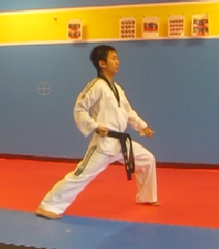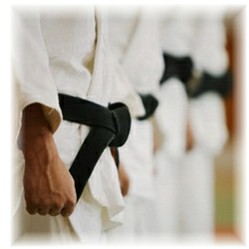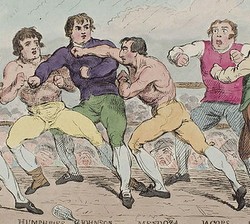Taekwondo forms, or poomses in Korean - taekwondo students usually either love them or they hate them. Whether or not the taekwondo student hates working at the forms, it is something they will have to learn if they want to gain a black belt. The properly carried out forms will help the student to be a little more comfortable in their stances as well as doing several moves back to back. A few other benefits associated with rehearsing the forms is enhanced balance, timing and coordination. Ideal breathing should also be used while doing the form reinforcing this routine on the student.

Taekwondo Forms
Learning the taekwondo forms can be difficult for some students, but it's necessary to learn them to achieve black belt.
Since taekwondo is a non-aggressive martial art all taekwondo forms start out with a defensive move. Following this initial defensive move the form will then go into counter attack moves, and may still throw in many defensive moves. The forms will grow to be a lot more difficult when the student advances to higher belts, introducing more advanced sequences of moves and even more of them.
Taekwondo forms are based off the actions required for the performer to protect against numerous assailants. While attempting to commit to memory the form it may be useful to think of the assailant assaulting as the movements are executed. Rehearsing the forms and becoming proficient at them helps the taekwondo student get accustomed to thinking about their stances in sequences. In a genuine fight knowing the forms isn't really likely to be of very much use, but what it really will have taught the student can be of help.
The various belt levels of taekwondo each have an associated taekwondo form. It's necessary for the student to remember all and demonstrate the right form to the instructor to progress to the subsequent belt level. When a student tests for their black belt they may be asked to execute several previous belt forms as well as in any order, so they shouldn't only be committed to short term memory. Higher belts may regularly be called upon to guide lower belts in perfecting their forms which is additionally beneficial to keeping the forms clear in minds of those holding higher belts.
Taekwondo Form
Palgwe Sam Jang
If as a student you happen to be having a tough time mastering a taekwondo form here a several things to utilize:
- Start with doing only the first couple movements in the form, then when they become habit add more moves.
- Imagine an opponent at just about every step, either blocking a punch from the attacker or throwing a punch their way
- Consult with the instructor for assistance, they've helped a lot of students through mastering the exact same form, and could well have advice on helping you to memorize it. It's uncanny how an instructor can know precisely where the student performing a form is stuck in the process and provide them the subsequent move.
- Perform the form daily, this should help set the moves into your brain.
- Picture yourself doing the form if you can't actually do it. Picture yourself doing while standing in line at the bank, etc.
- Aid another taekwondo student with the form, this will aid the pair of you.
There are various different sets of taekwondo forms, the Taeguek Forms (WTF - World Taekwondo Federation), the Palgwe Forms (ITF - Internation Taekwondo Federation) , the Pyong Ahn Forms, the Jhoon Rhee Martial Ballet, the Song Am Forms, and Chang Hon (Chon-ji) Forms. Different schools use different forms, even the same form can be executed slightly differently from one school to a second.
The Taeguek and Palgwe forms needed to earn a black belt are:
- Taeguek / Palgwe Il Jang - Heaven
- Taeguek / Palgwe Ee Jang - Lake
- Taeguek / Palgwe Sam Jang - Fire
- Taeguek / Palgwe Sa Jang - Thunder
- Taeguek / Palgwe Oh Jang - Wind
- Taeguek / Palgwe Yook Jang - Water
- Taeguek / Palgwe Chil Jang - Mountain
- Taeguek / Palgwe Pal Jang - Earth
The name of the form is usually stated at the opening of the poomse or form, i.e. "Palqwe Il Jang", right before the movements start.
You might also like
History of JudoMartial arts owes a lot to Dr Jigoro Kano, the founder of modern day Judo. Th...
Daniel Mendoza - the First Jewish Boxing ChampionDaniel Mendoza, or Mendoza the Jew as he proudly billed himself, was a profes...






 Scottish Highland Cattle For Saleon 05/22/2012
Scottish Highland Cattle For Saleon 05/22/2012
 Essential Silk Flower Making Supplieson 05/09/2012
Essential Silk Flower Making Supplieson 05/09/2012
 Kiddie Crafts: Childrens Projects For Making Doll Accessorieson 05/08/2012
Kiddie Crafts: Childrens Projects For Making Doll Accessorieson 05/08/2012
 Amazing Ideas For Making Handmade Greeting Cardson 05/06/2012
Amazing Ideas For Making Handmade Greeting Cardson 05/06/2012



Comments